Rory Woods will be speaking about welcoming our computer overlords in astronomy. Our society has seen computers become an important aspect in almost every facet of life. Within astronomy, computers are used to control our telescopes, process and analyze our images, and even create entire new (simulated) universes of our own. With every passing year simulations become more sophisticated as they increase in size, resolution, and physical detail, allowing us unique views into any possible history our Universe might have had.
This talk will give an overview of computers in astronomy. I’ll focus on the need for computing in observational astronomy and then on the history of astrophysical simulations. I’ll talk about some of the limits and challenges we face with trying to represent our Universe in a computer, and show some of the failures and successes we’ve had in doing so. I’ll finish by talking about the most recent, cutting edge simulations and about my own research in computational astrophysics.
Rory Woods is a PhD student at McMaster University as well as a presenter at the McCallion Planetarium and the Origins Institute 3D Theater. His research is on computational methods in astrophysics and is applied to galaxy formation.
Place and Time
We’ll be meeting at The Hamilton Spectator Building located at 44 Frid St, near the junction of Highway 403 and Main St West in Hamilton. Admission is free and everyone is welcome!
Door Prizes
There will be a draw for door prizes at the meeting and a free door prize ticket to all who arrive before the 7:30 start time!
Food Share Donations
Donations of non-perishable food for the Hamilton Food Share program will be collected at this meeting. Please drop off any items at the drop-box located near the entrance of the auditorium. All donations gratefully accepted and thanks to your generosity we’ve collected thousands of pounds of food since we began. Let’s keep up the great work as the need continues.
Post Meeting Summary
HAA Chair Jim Wamsley got the May HAA meeting under way at 7:30 p.m. sharp by welcoming everyone in the audience to the meeting. He invited everyone to get out to some of McCallion Planetarium’s shows at McMaster University, mentioned the proposed HAA bylaw change, and reminded HAA members to write articles for the E.H. Jim also reminded everyone about our Astronomy Day public viewing the following day (see gallery on Page 12), as well as a talk by 2nd Chair John Gauvreau at the Burlington Public Library that week.
Next, Observing Director Matthew Mannering gave his The Sky This Month talk, during which he mentioned Comet C/2012 K1 PanSTARRS, which is visible in the northern sky now, and the new Camelopardalids meteor shower. Matthew also mentioned the recent AstroCATS show in Hamilton and the visits & participation of various HAA members in it. Matthew’s main theme this night was Retrograde Motion of the planets at and around opposition or inferior conjunction, whichever the case may be. He talked about how retrograde motion was first explained by ancient Greek astronomers including Ptolomy as the planets orbiting around the Earth in “epicycles”, as illustrated in the classic “spirograph” diagram below. But of course we now know, the planets appear to shift back then forward again in our sky as Earth passes them (or as Venus or Mercury passes Earth) as all the planets orbit the Sun! Matthew talked about Jupiter, Mars and Saturn in the evening sky, Uranus, Neptune and Venus being in morning sky, the Spring constellations, DSO’s such as M13 & M44, and the “double-double” star quartet in Lyra. He also showed neat pictures such as a face made up of eclipsed moons, the recent solar eclipse as imaged from Australia and Antarctica, and Comet PanSTARRS passing galaxy M51.
After Matthew’s talk, we had our usual intermission, and then Les Webb & Alex Tekatch drew tickets for the door prizes and 50/50.
The second half of our May meeting featured main speaker Rory Woods of McMaster University, who gave his talk entitled “Welcoming Our Computer Overlords in Astronomy”. Rory’s talk was in 3 parts, the first of which was “A brief history of computing” starting with 1946’s ENIAC, then 1951’s UNIVAC, 1976’s Apple II, and 2013’s Intel Cor i7, Apple iPhone & SciNet array, and how computer processing power has exponentially exploded over that time. Part two was “Astronomy and Computers”. Rory talked about today’s amateur telescopes being equipped with GPS, autoguiding ports and DSO databases. He mentioned the 10 hours of super-computer processing time needed to produce the Planck Full Sky Dust Map, and the 12 days of supercomputing needed for the Herschel RGB composite of Perseus. Rory showed us a video of ESO’s Atacama Large mm/sub-mm Array and its supercomputing “correlator”.
Thirdly, Rory talked about “Simulating Our Universe”, and how, in 1941, Erik Holmberg used 74 light bulbs to simulate our galaxy! Nowadays, computers are used for simulating galaxy evolution, star-forming gas clouds and star cluster formation with radiation dynamics.
Thanks Rory for this very interesting and engaging talk!
Jim then closed the meeting by reminding the audience of the Astrophotography Group night, which took place on Sat. May 17th.

